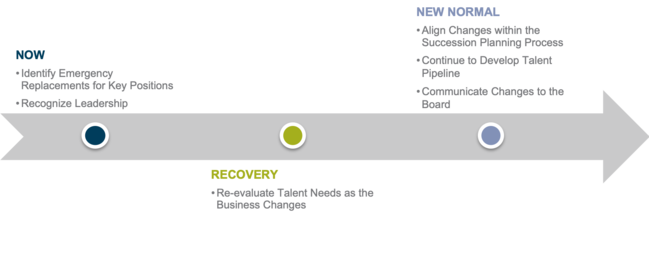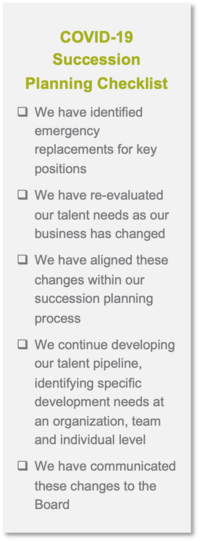The last couple of months have been a wake-up call for many organizations. The potential effect of COVID-19 on executive health has made Boards cognizant of the need to review their succession planning processes. A viable succession planning process is not only critical to business continuity but has become an important part of business interruption preparation. While many organizations are in survival mode and have postponed formal succession planning activities, there are still steps you can take to maintain a focus on the big picture and consider what to do now, in recovery and moving towards the future.

WHAT TO DO NOW
Identify Emergency Replacements for Key Positions
Often in succession planning, candidates will be designated as “Ready Now,” “Ready 1-3 Years” and “Ready 5+ Years.” Smart organizations also identify “Emergency Replacements” to seamlessly take over on a short-term basis. Although this might be the “Ready Now” candidate, it is often a well-respected leader or Board member who could manage the position, but either does not desire, or is not the right fit for, a long-term replacement.
CEO, CFO and COO are often the first positions designated as key, but be sure to not overlook other critical positions across the organization that are linked to value-creation and impact strategic outcomes. The best source to identify an emergency replacement is the current incumbent, as the designated employee will need to be familiar with the team and processes. Formally document the responses and communicate to the Board.
REAL-WORLD EXAMPLE: A mid-cap financial services client asked each of its Executive Leadership Team (ELT) members to identify an immediate back-up executive should they become sick with COVID-19 or have an unexpected temporary leave of absence. This was done swiftly and submitted to the CEO immediately. The CEO confirmed the Go To List, reviewing it for any “fatal flaws” prior to communicating the plan to each identified successor. It was made clear that these successors differed from the official Succession Plan, and in fact, most of those identified for temporary stand-in were chosen for different reasons than a long-term successor. The important skills for the temporary successor included a true sense of urgency, deep operational experience and excelling in emergency situations.
Recognize Leadership
New leaders have emerged during the crisis, prompting Boards and leadership teams to re-evaluate their current definition of high potentials and succession candidates. Clients have shared stories of employees who have stepped up and demonstrated leadership who were not part of the current talent pipeline. On the opposite spectrum, we are also hearing stories of leaders crumbling under pressure, unable to make decisions and communicate with employees, potentially derailing their high-potential status.
REAL-WORLD EXAMPLE: A healthcare organization recently identified some surprises in their leadership talent. A middle manager has unexpectedly risen to the top due to her proactive response during the crisis. This newly identified crisis leader proved to be a strong emergency operator during this unprecedented time. This manager excels at dealing with ambiguity, decision making and communication and leads with purpose.
WHAT TO DO IN RECOVERY
Re-evaluate Talent Needs as the Business Changes
As we slowly move into recovery mode, it is likely that your organization is not the same as it was a mere three months ago. Changes to the business necessitate changes to the succession plan. Questions to ask the leadership team include:
- How has our strategy changed?
- What does the business model look like in recovery?
- How does the leadership team need to change to reflect the changing business model?
- What are the future talent requirements?
- What are the current capabilities?
- Where are the gaps?
REAL-WORLD EXAMPLE: A financial services firm has found that its customers are driving the need for increased digital expertise. In this scenario, leaders who cannot adapt to the new pace, manage change or struggle with technology, will not survive as leaders. Instead, new competencies will be needed including adaptability, quick decision making and resilience.
WHAT TO DO IN THE NEW NORMAL
Align Changes within the Succession Planning Process
Based on the review conducted during recovery, now is the time to re-evaluate (or launch) your succession planning and development process. How does the evolving organizational structure align with your current succession strategy and approach? When strategy and competencies change, a revised assessment process may be necessary to evaluate the current pipeline and high potentials.
REAL-WORLD EXAMPLE: The CEO of a Chicago-based healthcare organization realizes that the competencies required in the past are not necessarily the same skills needed of leaders moving forward. He expects the strongest leaders will engage their teams, encourage autonomy, delegate authority and be willing to pivot quickly based on data from various sources. Their assessment process will be modified to ensure the organization is focused on both evaluating and developing these key competencies.
Continue Developing the Talent Pipeline
Succession planning is not an annual event. To be effective, it must be an ongoing process that includes continually identifying specific development needs at an organization, team and individual level. Recognize and communicate how the strategy will impact critical competencies and the talent requirements. Thoughtfully identify opportunities (competency development, education, on-the-job experiences, new assignments, etc.) to develop and retain those in the leadership pipeline. To minimize transition risks, ensure systematic planning and development of key leaders who are ready to advance into critical roles.
Communicate Changes to the Board
As the emergency replacements have already been communicated, work with the Board to discuss new updates to the succession plan, as well as individual development plans. Based on experiences with other organizations, Board members may provide additional insights that are valuable in the current environment.
Although these are ambiguous times, take some time to consider how a thoughtful process now can establish a foundation in recovery and when we arrive at the new normal.
Elevate Partners (a DHR company) advises clients on their most important leadership and talent management challenges. Whether your organization is identifying future CEO candidates, creating more effective teams, or coaching high potential talent, our team of experienced professionals help you make fast and accurate decisions. For more information, visit dhrelevate.com or call 312.775.1900.

